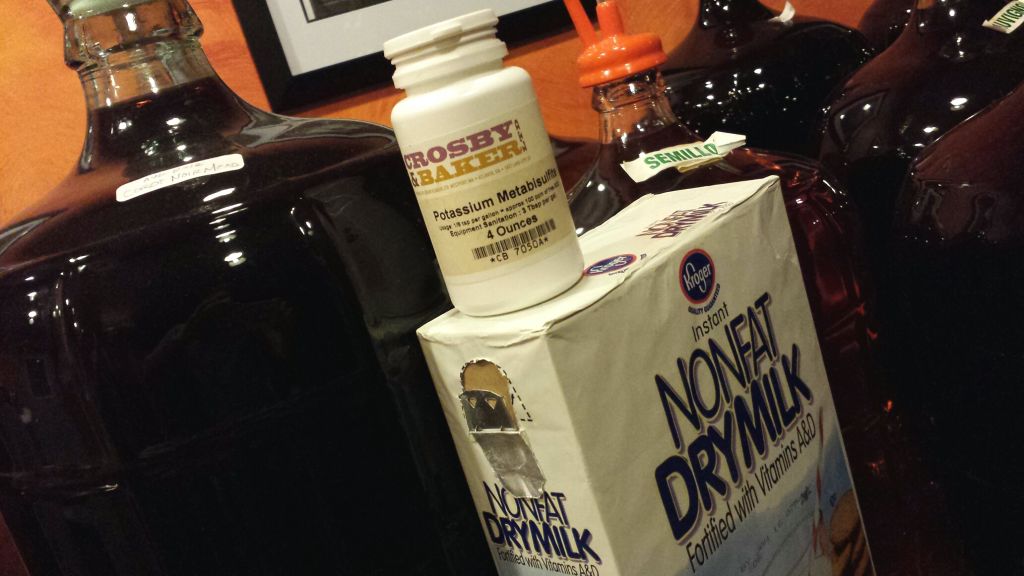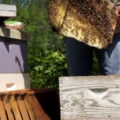I wrote this blog back in 2010 originally. For the record, I haven’t had to deal with oxidized wine since that time. Recently, I’ve been asked about correcting a wine that has oxidized. So, I dug it up and revised it a bit and here it is. Hope it helps.
If you are diligent in tending your wine, you may never experience oxidation. However, if you are like me and tend to experiment a lot, you might have more wine going than you can sometimes keep track of. While a balanced wine generally takes care of itself, sometimes I may check in on it a little later than I should. Meanwhile, perhaps the S02 levels may drop while I’m not looking. But let me be clear, I definitely won’t neglect my prize batches.
The reality of the situation is, I keep a cellar that is like a big test tube of experimentation. They say a good winemaker has a lifetime of experience. I believe that. My goal is to pack in more experience in less time to produce a better wine, sooner. So I experiment a lot and log everything.
I have experienced oxidation a time or two. The best way to describe oxidation is to cut up an apple and watch within seconds while it turns brown. Air is the enemy to wine. Air is also our enemy. Funny, we need it, but it too wears out our bodies and makes us grow old. There are several factors that can oxidize wine. Two most common are too much head space in the carboy, or too low of S02 levels in your wine. Be sure to mind these two things, and you may never experience oxidation.
Many people think when a wine has oxidized, you have to throw it out. Really, oxidation can be reduced, and in some cases eliminated by the use of powdered skim milk. It won’t win you any awards, but it can still become a good, drinkable wine again, reminiscent of the base you fermented. That is better than dumping it down a drain. Try this before you dump it.
The procedure:
- Calculate the amount of wine to be treated, in liters, and for each liter of wine measure out 0.5 gm of powdered skim milk into five (5) mL of cold water. Stir into a solution making sure all the skim milk is dissolved. NOTE: It is important that you use powdered skim milk, not de-creamed whole milk or malted milk.
- Now bring the S02 level of the wine up to the required amount with respect to the pH.
- Stir the wine vigorously and while it’s swirling, add the skim milk solution by pouring a single stream like what would come out of a sink faucet to make it enter the wine well below the surface. There may be a bit of foaming, but it will dissipate. Continue to stir the wine to ensure all the skim milk is well-distributed. It is important that the skim milk solution enters well below the surface. If you pour it on the surface, little, or nothing, will happen. I think the air is already having an effect on it. I have done this and botched ‘the pour’ before and it did nothing for the wine. Once the skim milk is fully distributed, brown curds will develop in the wine but will ultimately settle out.
- Replace the airlock and allow the wine to settle for 2-3 days. Meanwhile, prepare a fining agent for fining the wine if you want to try to polish the wine again. I have skipped this with good success.
- After 2-3 days, rack the wine off the oxidase curds into a clean carboy and stir in the fining agent (if you do one.) Allow this to settle for about 10 days, then rack the wine off the lees. Add an airlock. Filter. and bottle.
Let’s just try to avoid oxidation in the first place. Check your wine when it’s time, and make sure your sulfite levels are in line with the pH. When fermentation is complete, or when you know the wine is mostly degassed, ditch the airlock and plug that baby with something. I still have yet to find a decent stopper that I like, but I’m planning to be in stainless VC tanks soon. Have little headspace, or flood your headspace with an inert gas. I recommend Argon over CO2. We’re trying to degas our wine already and C02 being soluble, it can get back into the wine. Argon is better in winemaking.





Thanks Jason!
I’m glad I found your helpful & inspiring site.
I was about to dump a whole batch of pino grigo that became a rusty sherry.
I know what happened now & well, at least I’ll keep a few bottles to enjoy as “Sherry”.
By reading your explanation and remedy, I’ve come away with a much clearer picture of where I went wrong and how a PH balance and air dictate the outcome.
Now I just may be looking at your expertise on bee hives next!
I have some bee boxes I have to address.
You are a very busy person!!
Excellent, always happy to help. If you haven’t already, check out the group here where we talk about this, beekeeping and lot’s of other stuff! Happy Holidays! https://www.facebook.com/groups/morganranch/
Hello, I have 200 litres of red wine, made from Californian grapes and need some help. I am not sure that I understand how to carry out step # 2 and how much powdered milk to I need for 200 litres of wine?
Hi Lionello, step 2 is something that you will need to do in order to prevent oxidation from happening again. Get the pH of the wine and this chart will help you adjust the S02 to the proper levels. https://www.accuvin.com/wp-content/uploads/2015/04/How-SO2-and-pH-are-Linked.pdf – It really helps to have the ability to get the free S02 levels in your wine. I use the Vinmetrica SC-100 to do mine.
As for the amount of powdered milk, If you have 200L of wine, it’s 200 x .5g of powdered milk, and and 200 x 5ml of water.
Hello Jason,
I am experiencing a similar situation right now and what you wrote drew my attention. I have a wine made from 60 kg of syrah grapes. I think it oxidizes very little. At the first opportunity, I will try it according to the recipe you have given.
But can you explain in more detail how and why skim milk powder can correct oxidation?
Thanks once again for the information you shared.
Hi Engin, I admit I do not know the hard science behind it, but basically it’s a chemical attraction/bond of ions. The oxidase in the wine is attracted to the milk ions. Maybe someone who knows more can chime in. It is important that the skim milk solution enters well below the surface. That is… you stir the wine into a swirl and pour the solution in in a way where it goes beneath the surface quickly. If you pour it on the surface, little or nothing, will happen and it will eventually settle to the bottom. I’ve had a few failures. If successful, brown “curds” will develop in the wine and will also settle out. In both cases, you will rack the wine off the top of the settlement. Keep me posted on your progress.
CO2 is heavier than air. After degassing you can use a floating lit sulfur candle in a closed tank of wine to add SO2 gas (also heavier than air) as a shield too. If you are dealing with a much smaller quantity of wine such as a carboy that isn’t full you can remove the air by using a long wooden match. Once the flame goes out the oxygen has been removed. Seal the carboy immediately. Argon and Nitrogen are another way to purge out the oxygen but are more costly.
I have a 5 gallon carboy that I want to try your methed but I dont understand how you can stir the contents in a carboy and add the skim milk. Do I rack it off to an open container, stir, add the skim milk and then rack off to a carboy? Will it siphon with the curds developing?
Hi Buch, If your carboy is topped all the way up, take out about 1/2 gallon to a gallon to make some headspace. Mix up the dry milk solution as described have it in something that you can pour a nice even stream into the neck of the carboy. Get a stirring stick or wand down into the carboy and stir in a circular motion so that the entire of contents of the carboy is swirling in one direction… think of liquid swirling around a drain. When it’s moving, remove the stick and slowly pour in the milk liquid so that the stream goes in and directly beneath the surface. The idea here is to get it introduce cleanly into the wine without hitting the edges of the carboy and running down. There’s something about this that is important. It does not work as well if interacts too long above the surface of the wine. Once in, stir it a little more to integrate it and pour back in what you removed to create the space. Let it sit over night and come check it in the morning. It may need two days… but you should see all the curds settled to the bottom (and they are nasty looking. You will rack it off this.
Hi Jason, thanks for the reply, I made an acid adjustment to the wine before I started anything. I took it from 0.8 to 0 .7%. I had 5 gallons to work with, so I decided to do the procedure with 3 gallons and compare the results to the 2 gallons. This was Wednesday the 12th. On Sunday, I used a baster to pull samples from both and compare. The 3 gallons has lots of micro suspended solids or gas and no change in the brown tint or taste. I don’t see any curds at all but have not racked off. This is a red wine. What do you suggest?
Hi Jason, I followed the procedure about 4 days ago. All I see is lots of micro particles throughout the entire wine. I don’t see any curds. The brown tint is still there and perhaps worst since the addition. I have not racked the wine.
Hi Buch, replying to both your comments here. First, if the wine was badly oxidize, it’s possibly it beyind the point of return. I know that’s frustration, but we’ve all been there. When you say it has a brown tint, that kind of suggests it’s pretty bad. That said, I will always try this method before tossing it. Next, I have botched the addition of the milk before. When it’s not added “well below the surface” it doesn’t seem to be as effective. How exactly did you add it to the wine? Did you swirl it in a carboy or in a bucket? It’s harder to do in a carboy, but of course, putting it in a bucket exposes it yet to, more air. I really should make a video on this addition. If it’s splattered on the surface, then it doesn’t seem to work as well. When you say you see particulate, I have seen this before (vs full curds). Definitely rack it off… and don’t hesitate to do it again.
I bought a carboy stirrer that attaches to a drill. I did it in a3 gallon carboy and it was about 3″ or more below the surface. Should I add a fining agent and then rack it off after 2 days?
Sounds like you’ve done things correctly. If you are not happy with what you are seeing (and tasting), perhaps first rack off what is there, and try it again… wait a few days to see if you’ve caught any more oxidase. But yeah, in the end, you might try fining to polish it up. Again, just don’t be upset if the wine is too far gone. There is a point of diminishing return as only you know. There’s a point where you may just be done messing with it. Good luck.